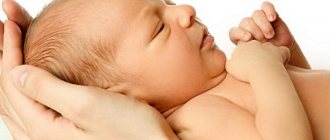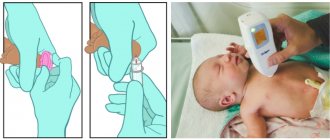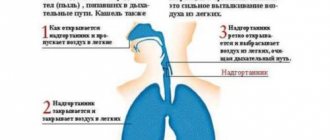Anatomical and physiological characteristics of newborn children. Transitional states of newborns.
A newborn baby is a human child from the moment of birth until he reaches the age of 28 days. A newborn baby born at 37-42 weeks of gestation is considered full-term. Premature - a child born at less than 37 weeks of gestation. A post-term baby is born after 42 weeks of pregnancy. No matter how similar a child may be to an adult in appearance in terms of the structure of his body and its individual organs, he differs significantly from him in many quantitative and qualitative characteristics. A newborn baby is helpless in its environment, poorly adapted to the environment, and requires comfortable conditions and care. Therefore, the mother is responsible for her child and is obliged to care for him. If for some reason she cannot care for the child, then the child’s right to life must be respected. Parenting a child is an art and a 24/7 job.
Anthropometric indicators of full-term, premature and post-term infants can vary widely. A full-term baby weighs more than 2800 grams. The first weighing of a newborn is carried out within the first hour after birth with an accuracy of 10 g. Height is also measured within the first hour after birth. The average body length of a full-term newborn is 48-53 cm. The head circumference of a full-term baby is 34-36 cm, and the chest circumference is 32-34 cm.
The condition of each newborn baby after birth is assessed using the Apgar score. Healthy newborn babies have an Apgar score of 8-10 points.
The skin of a newborn baby is tender, elastic, pink, with remnants of vellus hair. The epidermis (outer layer of skin) actually consists of one thin layer of cells. Its richness in vessels and capillaries, poor development of sweat glands and active activity of the sebaceous glands lead to rapid overheating or hypothermia of the child. A newborn has easily vulnerable, fragile, sensitive skin, which is also important to consider, because... With improper care, diaper rash appears, infection easily penetrates through the pores and pustules appear. Due to the high lipid content it is more permeable. On the back of the head, upper eyelids, between the eyebrows there may be bluish or reddish spots caused by vasodilation (telangiectasia), or pinpoint hemorrhages. Sometimes there are yellowish-white nodules (milia) on the wings and dorsum of the nose. All these phenomena disappear in the first months of life. In the area of the sacrum there may also be an accumulation of skin pigment, the so-called. "Mongolian spot" It remains noticeable for a long time, sometimes throughout life, but is not a sign of any disorders. A newborn's hair is up to 2 cm long, eyebrows and eyelashes are almost invisible, nails reach to the fingertips. And the most developed type of sensation in infants is the sensation of touch (tactile perception). Skin is a baby's favorite sensory organ. A huge amount of information is perceived through the skin. Therefore, it is necessary to create a thorough and gentle skin care.
Basic rules for proper care of a child's skin. Do not use detergents that are not specifically approved for use in the care of children's skin. Minimize exposure to external irritants (urine, feces, washing powder residues, etc.). Maintain natural moisture levels. Avoid rubbing the skin. Limit possible changes in the bacterial flora of the skin. When to bathe a newborn baby? Bath a child - if he has a normal temperature - no earlier than 6 hours after birth with a body weight of at least 2000 grams and in satisfactory condition. For bathing you need a warm room, warm water and bathe quickly. Dry quickly and thoroughly. Dress and wrap warmly. Next, you need to bathe your child every day. Decide when it is more convenient to bathe your child: in the morning or in the evening. It is better to do this before feeding, so that the baby does not spit up, but while he is not yet hungry. It is important that bathing is enjoyable and does not cause discomfort or fear. When starting bathing, you need to prepare in advance everything you need so as not to be distracted and not leave your child during bathing. In any case, if you need to answer the phone, take a towel, never leave the child alone in the bath - wrap him in a towel and take him with you. In order for the water to be softer and “dry” the child’s skin less, it is better to add bathing foam to the water. Use baby soap 2 times a week. From the first days you will need a bath for bathing. When washing girls, wash from the front, boys from the back.
The skeletal system of a newborn contains few salts, which give it strength. An infant feature is the presence of non-ossified areas in the skull - fontanelles. The large one, in the shape of a diamond, is located in the area of the junction of the parietal and frontal bones, dimensions 1.8-2.6 x 2-3 cm. The small one, in the shape of a triangle, is located at the convergence of the parietal and occipital bones and is closed at birth in most children . Such a soft connection of the skull bones is of practical importance when the head passes through the narrow birth canal. Its natural deformation into an elongated “pear” is not scary and should not cause “panic”. The correct outline is a matter of time. The head looks too large, because it is 1-2 cm larger than the chest circumference, the arms are much longer than the legs.
Their increased tone predominates in the muscular system - the arms are bent at the elbows, the legs are pressed to the stomach: the posture is uterine due to the preserved inertia. The neck does not support the head - its muscles are weak.
Respiratory organs - the mucous membranes of the respiratory tract are delicate, contain a large number of blood vessels, therefore, with infections, often viral, swelling quickly develops, a large amount of mucus is released, which greatly complicates breathing. The auditory, or Eustachian, tube is wider and shorter than in older children, which facilitates the penetration of infection and the development of otitis media. The lungs are underdeveloped, breathing is shallow and is mainly carried out by the diaphragm - a muscle located on the border of the chest and abdominal cavities. Therefore, breathing is easily disrupted by the accumulation of gases in the stomach and intestines, constipation, tight swaddling, pushing the diaphragm upward. Hence the wish - to monitor regular bowel movements and not to swaddle the baby too tightly. Tight swaddling should be stopped for several reasons: blocking the movements of the diaphragm reduces ventilation of the lungs, blood circulation in various parts of the body decreases, the thin air layer between the baby’s body and the diaper does not allow for heat retention, restriction of limb movements prevents the development of neuromuscular coordination, tight swaddling with the head makes breastfeeding difficult, since the baby cannot move his head and open his mouth wide enough to properly attach to the breast; swaddled babies sleep more and ask for the breast less. The peculiarity of breathing is that the newborn breathes frequently. In a full-term newborn, the respiratory rate during quiet wakefulness is 40-50 per minute.
The frequency increases even with light load. The cardiovascular system. With the birth of a newborn, changes occur in the circulatory system, first functional - the umbilical vessels and vein stop their activity, and then anatomical - the intrauterine blood flow channels close. The heart rate is 120-140 beats per minute; when feeding or crying, it increases to 160 beats or more.
Digestive system: functionally immature, and since newborns have an increased metabolism, it bears a heavy burden - minor errors in the diet of a breastfeeding mother and the child’s diet can cause digestive disorders (dyspepsia).
The mucous membrane of the mouth is rich in blood vessels, thin, and easily vulnerable. The tongue is big. The child is usually born without teeth. Sometimes 1-2 front teeth erupt even before birth. They may interfere with the baby's ability to breastfeed and are recommended to be removed by the pediatric dentist.
The muscles that block the entrance from the esophagus to the stomach are also underdeveloped - this leads to frequent, light regurgitation. To prevent it after feeding, you need to hold the baby for 20 minutes in your arms, vertically, leaning against your chest. Initially, the stomach holds about 10 ml of liquid, by the end of the first month its capacity increases to 90-100 ml.
The intestinal muscles are still poorly trained and the movement of food through it is slow. That is why newborns are so tormented by accumulations of gases formed during the digestion of milk and bloating - flatulence. Constipation is common. A child's original stool (meconium) is a thick, odorless, olive-colored mass that is released in the first 1-3 days. The number of stools is up to 6-8 times a day. Meconium is formed from amniotic fluid, mucus, and bile, which enter the stomach and intestines of the fetus. During the first 10-20 hours of life, the child’s intestines are almost sterile, then they begin to colonize it with the bacterial flora necessary for digesting food. Genitourinary system. By the time of birth, the kidneys, ureters, and bladder are quite well formed. However, severe stress experienced by a child during childbirth short-term disrupts metabolism. In the areas where urine is formed, uric acid crystals are deposited and the kidney function is slightly reduced for the first few days. The child urinates only 5-6 times a day. From the 2nd week, the metabolism gradually stabilizes, the number of urinations increases to 20-25 times a day. The external genitalia are formed. In boys, the testicles most often descend into the scrotum, but if they are in the lower abdomen, they can descend on their own in the first 3 years. In girls, the labia majora cover the labia minora.
Hematopoiesis. In newborns, the main site of hematopoiesis is the red bone marrow of all bones, additional sites are the liver, spleen, and lymph nodes. Blood parameters include hemoglobin 180-240 g/l, red blood cells 4.5-6.0 x 1012/l, leukocytes 18-21 x 109/l, with a crossover in the leukocyte formula at the age of 4-5 days of life.
Nervous system. Immature. The convolutions of the brain are barely outlined. They are more strongly developed in those sections where the vital centers responsible for breathing, heart function, digestion, etc. are located. In infancy, they sleep most of the day, up to 16-18 hours a day, for 3-4 hours at a time, waking up only from hunger and discomfort. Before feeding, they wake up on their own and usually need feeding on demand, after about 2-3 hours (this is the time for digestion of human milk in the stomach). Those children who do not wake up at feeding time (every 2-3 hours) need to be woken up and fed. For the growth and development of a child, the gripping reflex is important - when something touches the child’s lips, he opens his mouth, his tongue moves down and moves forward. Sucking reflex - when something touches the baby's palate, he begins to suck. Swallowing reflex - when the baby's mouth is filled with milk, he swallows. Protective reflex – when placed on the baby’s stomach, the baby turns its head to the side.
Sense organs. In the first weeks, the olfactory organs feel almost no smell; only an extremely loud sound can wake them up, and only too bright light can disturb them. The child’s thoughtless gaze does not linger on anything; many experience physiological strabismus caused by weakness of the eye muscles, involuntary movements of the eyeballs - nystagmus. A newborn focuses his gaze on an object at a distance of 20-25 cm from the organ of vision. This is exactly the distance between the baby's eyes and the mother's face during feeding. Up to 2 months he cries without tears - the lacrimal glands do not produce fluid. So far, only the senses of taste, touch and temperature sensitivity help him to understand the world.
Immunity - some factors that play a protective role in the body are developed in utero. The child receives some of the immune substances from the mother with colostrum, in which their concentration is very high, and with breast milk, where their content is much lower, but in sufficient quantities. But in general, the immune system is imperfect, the child is vulnerable to infection.
Diagnosis and differentiation of physiological adaptation processes from pathological ones has difficulties. One must be able to distinguish between physiological adaptation processes, transition states and pathological processes.
States and reactions that reflect the process of adjustment (adaptation) to new living conditions are called transitional (borderline, transient, physiological) states of newborns. The period of adaptation to the conditions of extrauterine life lasts about 3 weeks for full-term infants, and 4 weeks for premature infants. Usually physiological for newborns, transitional states under certain conditions, depending on the gestational age at birth, the characteristics of the intrauterine period and the birth act, environmental conditions after birth, care, feeding, and the presence of diseases in the child, can take on a pathological character.
Transitional states include an initial loss of body weight. A loss of body weight not exceeding 6-10% is observed in all newborns. Restoration of body weight occurs by the 6-8th day of life. Weight loss directly depends on the volume of milk sucked, fluid administration, the time of the baby's first attachment to the breast, and the temperature and humidity of the environment. Natural, that is, breastfeeding, is highly desirable for a child. And medical workers who come into contact with pregnant and nursing mothers should be supporters of this type of feeding.
Physiological jaundice in full-term newborns appears on average at 2-3 days of life and disappears at 7-10 days of life. It is observed in 60% of full-term and 805 premature children. Caused by increased breakdown of newborn red blood cells. With late feeding and hypothermia, it becomes pathological, requiring treatment (phototherapy).
Transient disturbance of thermal balance is also a transitional condition in the newborn, although it more often occurs with inadequate care. The normal level of body temperature for a newborn is 36.5-37.5ºС. Newborns easily overheat and cool down when the temperature regime is violated. A decrease in body temperature to 36ºC is defined as cold stress. Severe hypothermia is diagnosed at 35.9-32ºС. Severe hypothermia - when the body temperature is below 32ºC. Transient hyperthermia occurs on the 3-5th day and, under optimal conditions for nursing a child, is very rare. There is an increase in body temperature, sometimes up to 38ºС and above. The child is restless, drinks greedily, has dry mucous membranes, and has lost a lot of weight. The most common cause of hyperthermia is dehydration, water imbalance, overheating (at an air temperature above 24ºC in a ward for healthy newborns, the bed is located near a heating radiator, in direct sunlight). With proper and free breastfeeding, it is rare. Transient hyperthermia requires intervention - the child is left unwrapped, additional fluids are prescribed, and physical cooling measures are usually sufficient. In rare cases, antipyretics are used.
A hormonal crisis after birth is observed in boys and girls. There is engorgement of the mammary glands, and in girls there is bloody discharge from the genital opening.
Simple skin erythema is a physiological redness of the skin observed in the first 1-2 days. Occurs after removal of the original lubricant, the first bath. Does not require treatment. Erythema toxicum - many newborns develop small white papules during the 1st-3rd day of life, which usually disappears after 2-3 days. For severe toxic erythema, it is advisable to prescribe antihistamines.
Rejection of the umbilical cord and epithelization of the umbilical wound occurs by the end of 3 days. Epithelization of the umbilical wound ends by the 10-19th day of life. The umbilical cord stump is treated with 70% alcohol and 5% potassium permanganate solution 2-3 times a day. The umbilical wound is also treated with either 3% hydrogen peroxide and a 2% solution of brilliant green (brilliant green).
In order for borderline conditions of newborns not to become pathological, an optimal thermal regime is necessary (room temperature not lower than 24ºC, humidity 60%), early skin-to-skin contact within 40 minutes immediately after birth (for seeding with the mother’s flora), early attachment to the mother’s breast and feeding the child with breast milk, timely measures to stimulate lactation in the mother, keeping the skin and umbilical wound clean.
Full term baby
The main criterion for full-term (or prematurity) according to modern concepts is the duration of intrauterine development of the fetus (previously, the main measure of this condition was data on the child’s body weight at birth). A baby born at a gestational age of at least 38 weeks is considered full-term. The body weight of full-term newborns ranges from 2500 to 4000 g, averaging 3300-3700 g. In girls, it is 200-300 g less at birth than in boys. Newborns weighing 4000 g or more are considered large and are at risk due to the possibility of developing complications during childbirth and the postpartum period. All newborns lose an average of 200–300 g of their body weight in the first days of life. This is the so-called physiological loss of weight, associated with the loss of fluid and part of the energy reserves (in particular, glucose), for the rapid restoration of which the child is not yet ready. By the 7-10th day of life this loss is compensated. In the first month of life, the child’s weight gain is up to 600 g or more. According to some scientists, feeding children immediately after birth can prevent weight loss in the first days of life. An equally important criterion for the full-term birth of a newborn is body length at birth. It ranges from 48-58 cm, averaging 52-53 cm (girls are usually 1-2 cm less than boys). The circumference of the head and chest is on average 34-35 cm (0.5-0.7 cm less in girls). A healthy full-term newborn has smooth, elastic, pink skin, covered in many places with a cheesy, so-called birth lubricant. The sweat glands of the skin, still poorly developed at birth, subsequently protect the child from overheating; the sebaceous glands, thanks to their secretion, make the skin elastic, soft, velvety, protecting it from drying out and cracking. An important property of the skin and mucous membranes of a newborn is the ability to secrete protective antimicrobial substances, in particular lysozyme. More of them are released if the skin is clean, when its pores are not closed by its own metabolic products and elements of the external environment. Clean and undamaged skin better protects the child from many pathogens. The cry of a full-term newborn is loud, muscle tone is good, and movements are active. His basic physiological reflexes are quite well expressed. Immediately after birth, a child can not only suck (sucking reflex) and swallow (swallowing reflex), but also has a whole complex of innate motor reflexes (grasping, supporting, stepping, swimming, crawling reflex, etc.). Body temperature in various children ranges from 35° with tenths to almost 37°, most often within 36°. During the day it can fluctuate somewhat, which corresponds to the biorhythms of the vital functions of various organs and systems of the body. So, in the morning the body temperature is slightly lower than in the evening. However, for the same child during the day it should not, as a rule, deviate by 0.5-0.7 degrees. A full-term baby has large and small fontanels on the head - areas of loose connection of the skull bones, which are gradually covered by bone tissue as the child grows. During the newborn period, the formation and improvement of the child’s sense organs is clearly visible, some of them are already quite satisfactorily developed at this time. Thus, in a full-term baby, already in the first week of life, a pronounced function of the taste apparatus is detected. He reacts differently to taste sensations. Sweeter foods, as a rule, evoke positive emotions: the child calms down, licks his lips, swallows easier, and even becomes addicted to sweets. At the same time, bitter, sour or salty (given, for example, in the form of medicine) causes anxiety, screaming, protest in the form of refusal to suck and swallow. A newborn’s sense of smell is also developed to a certain extent from the first days of life. When the mucous membranes of the upper respiratory tract are exposed to irritating gaseous substances, the child becomes restless. He may refuse the breast if it is treated with any aromatic medicine (for example, in case of cracked nipples, etc.). The sense of touch is relatively well developed. The newborn reacts quickly to touches on his skin and mucous membranes, feels his mother’s breast well and, being hungry, imitates sucking movements at the slightest touch of his lips to it. 3, at the time of birth, a child’s vision is limited to the perception of relatively bright light, he does not yet have spatial perception of objects, and the movements of the eyeballs, as a rule, are not coordinated, which can even cause some temporary physiological “squint.” 1
Newborn baby
First assessment
Immediately after birth, the baby receives its first assessment. To determine a child's health and predict its development, doctors use the 10-point Apgar scale, developed back in 1953.
The Apgar scale is designed to assess the color of the skin, the nature of respiratory movements, cry patterns, heart rate, muscle tone and reflex reactions. All these parameters are scored ranging from zero to two points.
The higher the score, the better the baby feels and the more optimistic the prognosis for his further physical and mental development.
Important! A low Apgar score is not a death sentence. Timely medical care can give the baby a chance for normal development.
First measurements
The average body weight of a full-term baby is 3400–3500 grams for boys and 3200–3400 grams for girls. Average height can range from 45–54 centimeters.
Body weight and length at birth are influenced by many factors: the health of the mother, the characteristics of her diet during pregnancy, the height and weight of the parents, as well as the presence of bad habits. Babies of mothers who smoke are usually born with a lower birth weight than those of non-smokers.
In the first days of life, the baby loses a little weight, normally no more than six percent of body weight. The so-called physiological decline affects. The most weight is lost in the second to fourth days after birth. Weight is restored, as a rule, by 7–12 days of life.
What does he look like
The skin of a healthy newborn is elastic, firm and velvety to the touch. At the same time, it is very thin, sensitive and dries out easily. The baby's sweat and sebaceous glands are not yet very active.
Almost the entire body of the child is covered with fine hairs. Most of them are on the shoulders and back. In a couple of weeks they will begin to fall out.
There is also hair on the head of a newborn. Usually no longer than two centimeters. Children are often born with fully formed hair.
Newborn babies also have fully formed nails with which they can accidentally scratch themselves. In the first days of life, pediatricians recommend putting fingerless sleeves on babies’ arms – “anti-scratch sleeves” – or using special cuffs on the sleeves of blouses.
How does his body work?
In the first two or three days of life, the baby produces so-called original feces - meconium. It is thick and dark-colored.
From the seventh to eighth day of life, the child develops a normal stool. It is yellow, with a sour smell.
The child's gastrointestinal tract is not yet developed. Few gastric juice enzymes are produced, bile is poor in acids, and intestinal contractions are weak.
All these features make it difficult for the baby to digest any food other than mother’s milk or formulas that replace it.
In addition, the baby still has an imperfect thermoregulation system - he can easily overheat or become hypothermic. In the first weeks of life, you need to especially carefully monitor whether the child is dressed comfortably enough and protect him from drafts. How do his senses work?
A newborn baby has difficulty distinguishing surrounding sounds, does not focus his gaze, and does not distinguish all colors. At this time, the baby’s acquaintance with the world is carried out mainly through tactile sensations.
Therefore, it is very important for him to feel the warmth of his mother’s body, hear her voice and heartbeat - everything that accompanied his intrauterine life.
In the first days, pediatricians recommend holding the baby as often as possible, especially when he cries. This will make the baby feel protected.
The most important
In the first hours of life, the baby receives his first assessment and learns to live in a new world. He is very vulnerable, and it is important for him to feel the warmth of his mother’s body, hear her voice and heartbeat - everything that accompanied his intrauterine life.
PHYSIOLOGICAL WEIGHT LOSS IN NEWBORNS
When your baby finally comes into this world, along with the news of his birth, you happily inform all relatives and friends of two important numbers - the baby’s height and body weight (or, as is usual for most, weight). However, by the time of discharge from the hospital, the baby’s weight in most cases decreases slightly. This means that a physiological loss of body weight, characteristic of the newborn period, has occurred. What is it and should I worry if the baby has lost a little weight? Normally, the decrease in body weight should not exceed 5-8% of the child’s birth weight. That is, if the baby weighed 3000 g at birth, then a physiological loss of up to 240 g is quite acceptable. If weight loss is greater, the doctor must take all necessary measures to prevent further weight loss. Maximum weight loss is observed in most full-term newborns on days 3–5 of life; body weight restoration occurs 6–12 days after birth. In premature babies, weight loss also depends on birth weight, but it is restored only by the second or third week of life, and even then not in all newborns. There are three degrees of loss of the initial body weight of the newborn:
- first degree (weight loss is less than 6% of birth weight). In this case, the child does not show signs of dehydration, but there may be greed during feeding and anxiety. At the cellular level, laboratory studies reveal minor signs of intracellular hypohydration. Most newborns belong to this group.
- second degree (newborn weight loss within 6-10%). In this case, some signs of dehydration may appear: thirst, brightness of the mucous membranes, pallor of the skin, increased heart rate, shortness of breath, and irritability is noticeable in the child’s behavior. In laboratory conditions, signs of intracellular hypohydration and extracellular dehydration are observed.
- third degree (weight loss more than 10%). In this case, signs of dehydration are more pronounced: severe thirst, dry mucous membranes and skin, shortness of breath, severe tachycardia, increased temperature, the child behaves restlessly or is inhibited. In the laboratory, pronounced signs of intracellular and extracellular hypohydration are observed.
Losing more than 10% of body weight can lead to a significant deterioration in the child’s condition, so the doctor individually decides on the need for additional supplementation or formula feeding. Let's figure out what can cause weight loss: dehydration due to significant energy expenditure by the body. Indeed, in the first days of life, the child receives a very small amount of colostrum - from a few drops to several milliliters, while spending a significantly larger amount of energy. In addition, some children suck very sluggishly in the first days, which also contributes to a longer development of lactation and, accordingly, slows down the rate of weight gain in the baby; fluid losses associated with evaporation through the skin; fluid loss associated with the release of urine and meconium (this is original feces - a dark-colored mass formed from amniotic fluid swallowed by the baby and secretions of the digestive system); prerequisites for a more pronounced weight loss may be prematurity of the baby, birth weight more than 4 kg, difficult or prolonged labor, early rupture of amniotic fluid, and the presence of birth trauma. Prevention of excessive weight loss in a newborn can include early breastfeeding, free breastfeeding, and rational temperature conditions in the room where the child is.











